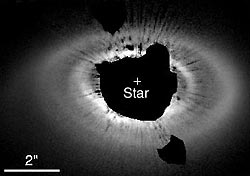
A dust disk around the young star HD 141569. If the dust disappears into planet formation, an invisible gas disk may remain. (The black areas have poor data, and the radial streaks are artifacts.)
Courtesy Mark Clampin et al.
Astronomers aren't sure how long it takes to form planetary systems like our solar system. They know the basics. A cloud of interstellar matter falls together under its own gravity; the cloud shrinks to form a spinning star surrounded by a rotating disk; dust in the disk starts sticking together in clumps; the clumps grow big enough to start collecting matter faster by gravity; the process continues until all the dust and gas in the disk are incorporated into planets or blown away. The mystery involves the timescales. Most young stars of roughly the Sun's mass (known as T Tauri stars for their prototype in Taurus) appear to blow away their dusty disks in less than 10 million years and perhaps just 3 million years. And this poses a paradox. Well-established theories strongly suggest that gas-giant planets like Jupiter take more than 10 million years to grow.
Yesterday at the American Astronomical Society meeting in Nashville, Tennessee, two teams of astronomers, working independently, announced that they have found puzzle pieces that may help solve the mystery.
One team painted a picture that, at first blush, seems to confirm the paradox. Elizabeth Lada (University of Florida, Gainesville) and Karl Haisch (University of Michigan) observed young solar-type stars in an effort to constrain the timescales for planet formation and the lifetimes of protoplanetary disks. Using a 2.1-meter telescope atop Kitt Peak and a 30-meter millimeter-wavelength radio telescope near Granada, Spain, the pair assayed newly forming star clusters in Orion and Perseus. Their infrared and millimeter-wave observations clearly indicate that stars in very young clusters (1 million years old or less) are girdled by dusty disks. But half of these stars lose their disks by 3 million years, says Lada, and 90 percent are diskless 6 million years after birth. This implies that "the building blocks for planets must form very quickly," Lada explains, and therefore that gas-giant planets must form much faster than theory says.
Or perhaps not. Coming to the rescue was a team from Vanderbilt University. Jeff Bary and David Weintraub suspected that the theory of planet formation is on target and the observations of early-vanishing disks are correct. They have proposed a solution that should please everyone. "Naked" T Tauri stars, those that seem to lack disks, have them after all, say Bary and Weintraub. The disks have merely turned invisible.
Dust disks are most often seen by their infrared and millimeter-wave glows: thermal emission from the dust particles. Bary and Weintraub propose that as dust grains stick together in ever-larger clumps, their total surface area declines, thus reducing their emission. In this view the naked T-Tauri-type stars aren't really naked, they're just wearing invisible clothes.
To see the "invisible," the pair looked for molecular hydrogen gas. Since young solar-type stars emit X-rays, the astronomers reasoned, the X-rays should stimulate any hydrogen molecules in the gaseous component of the disks surrounding them.
Sure enough, slight amounts of X-ray-excited molecular hydrogen appeared in 13 T Tauri stars targeted by the team. Moreover, the same amount of X-ray-induced molecular-hydrogen glow was found in stars with prominent infrared disks. Therefore it seems that "diskless" T Tauri stars may indeed have gaseous disks after all, and nascent Jupiters may have all the time they need to accrete gaseous envelopes around their more quickly built rock-and-ice cores.
Moreover, these results fit with those of Lada and Haisch — assuming the planet-formation models undergo a slight modification.
"You are losing the dust [within 3 million years]," says Lada. "That is unambiguous. If dust and gas are coupled" (a longstanding doctrine among astronomers), "then the gas should go away on the same timescale." However, if dust and gas become decoupled, says Weintraub, "It is conceivable that the planet-forming process is well on its way at 3 million years. Perhaps if the dust simply accretes, it wouldn't get rid of the gas. So if there are planetary cores massive enough to grab onto the hydrogen, then planets can form."
In other words, the dust all vanishes into planetesimals in 3 million years, while copious hydrogen remains to form giant planets on a more leisurely timescale. The paradox appears solved.
Bary and Weintraub plan to observe 50 more T Tauri stars with the 8-meter Gemini South telescope in Chile. Lada and Haisch plan followup observations as well.
Sky & Telescope editors David Tytell and Joshua Roth are in Nashville this week covering the American Astronomical Society meeting, the semiannual convention of the nation's professional astronomers. Watch SkyandTelescope.com for more of their breaking news reports.
 0
0
Comments
You must be logged in to post a comment.